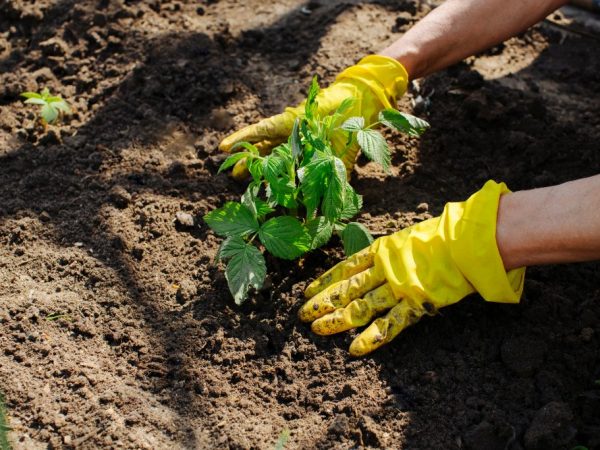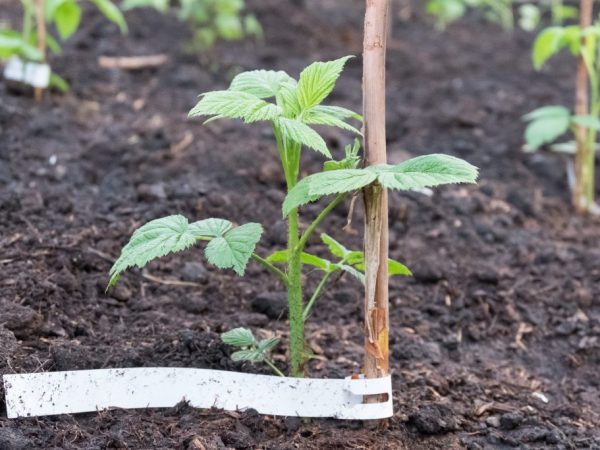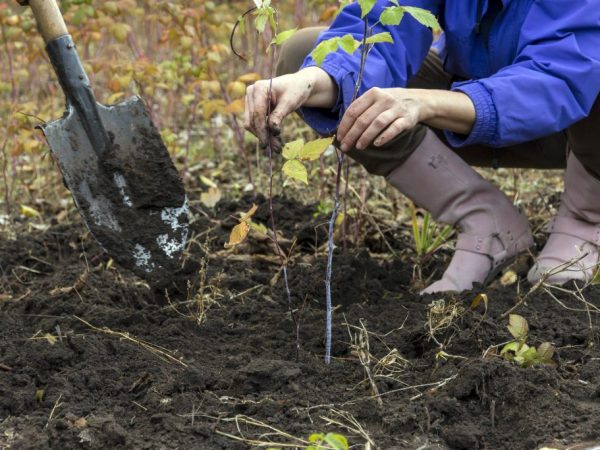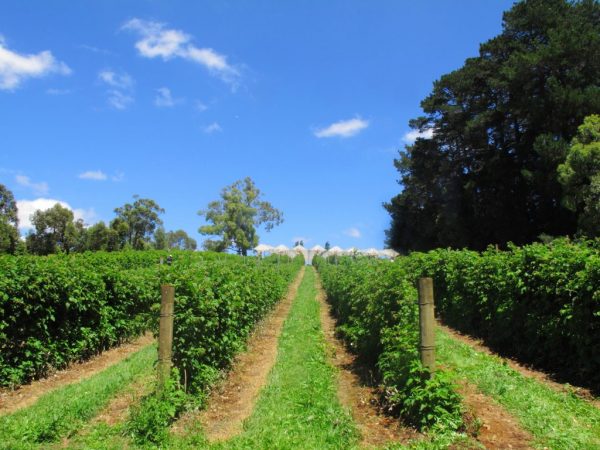Rules for the autumn planting of remontant raspberries - step by step instructions
The remont raspberry is a very popular crop. If planted in the fall, it will bear fruit until frost. There are many known landing methods, each summer resident selects the most suitable one for himself. Particular attention is paid to the choice of location and soil.

Rules for the autumn planting of remontant raspberries - step by step instructions
Features of the variety
The advantages of remontant raspberries are that they bear fruit twice a season: first in summer, then in autumn.
The annual plant produces a crop once, in late August or early September. But next year the berries will ripen by the end of June. Moreover, their quality will differ significantly - they are small, uneven in shape and dryish.
As a rule, the bushes give all their strength to the ripening of the first wave of berries, as well as to the growth of young shoots.
Most grow this crop for the purpose of harvesting only one crop. In order for the raspberries to bear fruit again next season, they are pruned closer to winter (the exact time depends on the climatic characteristics of the region). Optimal terms: late October or early November.
When to plant
Planting remontant raspberries can be carried out from early spring to mid-autumn. The timing depends on the climatic zone, and for most gardeners, the lunar calendar is the main criterion.
Lunar calendar
In order for the bushes to bear fruit well, it is necessary to carry out caring manipulations in a timely manner. Planting, mulching, fertilizing seedlings is important to do at the most appropriate time. Timely measures taken will increase the yield several times.
Spring planting of raspberries is appropriate for regions where the first frosts are observed already in September.
Favorable days for gardening:
- September: 1-7, 24, 28-29, 30.
- October: 1-3, 6, 24-30.
- November: 1 to 10, 24 to 26.
Unfavorable period for disembarkation:
- September: 16-19, 20-25, 30-31.
- October: 15-17, 28-29.
- November: 14, 15 and 16.
In addition to the calendar, adhere to the basic requirements: plant before bud break, while the average daily temperature should be 10-15 °. It is important to make the site in advance.
By region
As mentioned earlier, it is recommended to plant raspberries depending on the region of residence.
- In the North-Western Territory, Siberia, the Urals and the Leningrad Region - at the beginning of autumn, since the first frosts in this area come very early.
- In the southern part - until the end of October.
- In the Moscow region and the Middle Strip - until the end of September.
Site selection and soil preparation

Protect bushes from winds
Repaired raspberries should grow further from swampy areas, but the occurrence of water at a meter depth will not harm, since the length of the root system does not exceed 40 cm.
The culture is planted in well-lit places, the sun should fully warm it up.
With a lack of light, young shoots will begin to stretch, and foliage will fall off on the lower part, this will lead to a loss in the quality and quantity of the crop.
It is advisable that the shrubs do not succumb to strong winds.
You should not plant a raspberry tree next to trees, it is better to plant it along a fence and other low fence.
Nearby, you can sow marigolds, oregano, parsley, garlic, basil or thyme. The best neighbors are gooseberries, currants and honeysuckle.
The soil is chosen neutral. To determine the level, you need to see if there is a plantain or horsetail nearby - their presence indicates that the soil is too acidic.
You can reduce acidity with chalk, hydrated lime, or dolomite flour.
Experienced gardeners do not recommend planting the plant in soil with clay or sand, since the raspberry tree will often have to be watered and fed with minerals.
To always have a good harvest, a year before planting the material, green manures are sown on the proposed site - they cleanse them of harmful substances, improve the structure of the earth, and if you dig them up in the fall, it will be a good fertilizer. Such crops are chosen: oats, mustard, lupine.
Preparation of seedlings
There are several known breeding methods for raspberries. Some gardeners use root cuttings, but it is safer to plant the plant with seedlings.
The planting material should be strong and healthy, the diameter of the stem at the base is 5 to 8 mm, and the root system is well developed.
The aerial part consists of several shoots 1 cm thick.
It is important to pay attention to the renal system - these are thin and curved roots, they grow from the main roots, bend easily and do not break. Their length is 18-20 cm, while there should be quite a lot of them (the more, the better).
If, when buying seedlings, a small amount of dried roots is noticeable, it's okay, they are carefully cut off using sharpened secateurs or garden shears.
It is not necessary to buy large bushes, as they do not take root well. It is required to transport the purchased planting material carefully so as not to break the shoots and damage the root.
To do this, it is wrapped in a damp cloth, and if it is not possible to place them on the day of purchase, then the plants are added dropwise on the site before planting.
Do not transport the plant in plastic bags, otherwise the root may rot.
Planting methods

A sunny place is suitable for planting.
The options directly depend on the personal preferences of the owner and the general characteristics of the site. There are several effective methods for planting raspberries in autumn correctly. Let's consider the most popular methods.
Tape
This option is also designated as trench. The disadvantage is that the method is physically and time consuming. However, the correct strip planting scheme for raspberries allows you to achieve good results.
The shrubs will receive a sufficient amount of nutrients, each seedling will receive the maximum benefit from the care and will bear fruit on time.
Stages:
- First, trenches are prepared. This is done in the spring, a month before disembarkation, in warm weather.
- They choose the most suitable site, clean it of debris, weeds and unnecessary items. A black film or roofing material is laid between the rows.
- With the help of a rope and wooden pegs, mark the site and dig a trench (depth - up to 50 cm; width from 45-60 cm). Compost, fertile soil, humus or leaves are placed on the bottom. The next layer - top dressing, consists of superphosphate in a proportion (150 g / m²).
- At the last stage, wood ash is added: 500 g / m².
Attention! Do not use nitrogen, otherwise the seedlings will not take root.
Previously harvested planting materials are lowered into the belt ditch. The distance between the bushes should be 30-75 cm.
The roots are buried in depth. Sprinkle with soil so that moisture remains in the future. Watering the bushes.
Square-bush
Most summer residents prefer this scheme. If the instructions for disembarking are followed, then the number of shoots will increase rapidly, and the bushes will be fluffy.
Plants should preferably be planted on the south side of the plot. There must be a fence or other fence on the territory that will serve as a support.
The distance between seedlings is 0.9-1.5 m. The depth of the pits is no more than 0.5 m, the diameter is the same.
Repaired raspberries love mineral-rich soil. Planting in autumn and spring involves different feeding methods.
It is recommended to apply the following amount per hole:
- compost or humus - 3 kg;
- wood ash - 50 g;
- ammonium nitrate - 12-17 g;
- superphosphates - 20-35 g.
These proportions are calculated for the autumn planting of seedlings. In the spring, the amount of fertilizer for each item should be as follows:
- compost - 4 kg;
- ash - 60 g;
- saltpeter - 15-22 g;
- superphosphates - 30-40 g.
Raspberry branches are placed separately - one in each hole. After planting, the plant is watered abundantly and, if possible, shaded.
Do not plant the plants too deeply, otherwise it will develop slowly, and the root buds will begin to rot. After watering, the soil is sprinkled with sawdust or straw.
Curtain

Plants need good care
This option is similar to the previous one: the soil is prepared and fertilized in the same way. The difference lies in the distance and number of pits:
- Saplings are planted in small groups of 2-3 plants in one hole.
- 60-70 cm are left between the bushes. In the future, you can put a thread or wire between them, which will allow you to tie a raspberry tree.
Triangular scheme
This method involves planting seedlings, resembling an isosceles triangle, with sides of 0.4-0.5 m.
This option is most often used to design a garden plot.
Choose bright varieties (with red, yellow or orange berries). For each group, 6-8 seedlings are taken.
Care
After planting remontant raspberries, the plant must be properly cared for.
The first step is to prune the plantings (if the seller has not done this). The stem height should be 15-25 cm, you can focus on the number of buds, as a rule, I leave 3-4 pieces.
Watering the bushes is recommended after the soil dries out. In cool and cloudy weather - by sprinkling in the heat - at the root. This will protect the culture from burns.
By the end of summer, the number of watering is reduced so that the raspberries can fully ripen and get stronger.
For the entire season, the culture is fed at least twice.
- The first is before bud break;
- The second is before flowering, about two weeks before.
With the help of a sharp shovel, they get rid of the powerful root growth. Thick shoots, it is important to tie or fasten to the trellis.
To prepare the raspberry tree for wintering, autumn pruning of fruiting stems is carried out, thanks to which they will get stronger and absorb as much nutrients as possible.
As a preventive measure against pests and diseases, raspberries are treated with special preparations. It is important that they contain the optimal amount of Fitolavin.
Possible mistakes
The desire to plant a crop on a personal plot is not enough. It is worth preparing for this business in advance in order to avoid major mistakes:
- Incorrectly selected planting material. Bypass bushes with a weak, dry and damaged root system. Also, the absence of white buds on the roots indicates the low quality of the product. A long "stick" with a lush crown of leaves is unlikely to take root.
- You should not transplant the culture during an unfavorable period. Planting dates depend on the weather and climatic characteristics of the region of residence.
- Prepare the soil thoroughly. You should not plant the plants on fresh manure or sprinkle them with a large amount of tyrsa, because the culture can damp and rot.
- Failure to respect the distance between seedlings and the wrong depth of immersion in the ground.
- Not all gardeners prepare raspberries for winter.It is important to observe the timing of pruning so that the culture has time to get stronger and gain strength, which will allow it to overwinter.
Summing up
Gardeners annually come up with new planting schemes for remontant raspberries, which they implement both on horizontal sites and on elevated ridges. Some even plant in pots.
Before planting, you should decide which variety will be the most successful. With regular and proper maintenance in the spring and fall, gardeners achieve excellent results.

